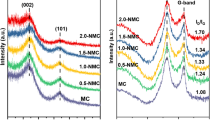Abstract
Advanced oxidation processes based on peroxymonosulfate (PMS) activation are widely used for the removal of antibiotic contaminants. However, the commonly used transition metal catalysts suffer from secondary contamination due to ions leaching during the activation of PMS. Herein, the oxygen and nitrogen co-doped carbon material (Nv-NC-2) with abundant mesopores was obtained by simple high-temperature calcination using covalent organic frameworks (COFs) as precursors and NH4Cl as an activator. The Nv-NC-2/PMS system exhibited excellent levofloxacin removal efficiency under a wide pH and complex water environment with anions interference. The C=O in Nv-NC-2 was identified as the main active sites through degradation experiments and XPS. Furthermore, the electron paramagnetic resonance, quenching experiments and probe capture experiments demonstrated 1O2 and \({\text{O}}_{2}^{ - }\) were dominant active species. This study enhances the catalytic activity of COFs-derived carbon materials through a simple activation technique, which provides a novel method for surface modification of carbon materials.









Similar content being viewed by others
Data availability
Not applicable.
References
A.L. Batt, I.B. Bruce, D.S. Aga, Environ. Pollut. 142, 295 (2006)
A. Bielen, A. Šimatović, J. Kosić-Vukšić et al., Water Res. 126, 78 (2017)
B. Xue, R. Zhang, Y. Wang et al., Ecotoxicol. Environ. Saf. 92, 229 (2013)
M. Esmati, A. Allahresani, A. Naghizadeh, Res. Chem. Intermed. 47, 1447 (2021)
H. Dong, X. Yuan, W. Wang et al., J. Environ. Manag. 178, 11 (2016)
J.N. Russell, C.K. Yost, Chemosphere 263, 128177 (2021)
S.D. Goodwin, H.A. Gallis, A.T. Chow et al., Antimicrob. Agents Chemother. 38, 799 (1994)
L. Saya, V. Malik, D. Gautam et al., Sci. Total Environ. 813, 152529 (2022)
L. Cizmas, V.K. Sharma, C.M. Gray et al., Environ Chem Lett. 13, 381 (2015)
Q. Zhao, M. Li, K. Zhang et al., J. Environ. Manag. 262, 109795 (2020)
J. Wang, S. Wang, Chem. Eng. J. 334, 1502 (2018)
Q. Yi, Z. Li, J. Li et al., Res. Chem. Intermed. 49, 655 (2023)
Y. Lee, S. Lee, M. Cui et al., Chem. Eng. J. 413, 127487 (2021)
M.S. Kim, K.-M. Lee, H.-E. Kim et al., Environ. Sci. Technol. 50, 7106 (2016)
S. Wang, J. Wang, Sci. Total Environ. 658, 1367 (2019)
P. Ye, M. Wang, Y. Wei et al., Res. Chem. Intermed. 45, 935 (2019)
B. Bouzayani, E. Rosales, M. Pazos et al., J. Clean. Prod. 228, 222 (2019)
M. Chen, L. Zhu, S. Liu et al., J. Hazard. Mater. 371, 456 (2019)
S. Wacławek, H.V. Lutze, K. Grübel et al., Chem. Eng. J. 330, 44 (2017)
M. Du, Q. Yi, J. Ji et al., Chin. Chem. Lett. 31, 2803 (2020)
Q. Hou, L. Qin, X. Peng et al., Res. Chem. Intermed. 48, 3753 (2022)
G. Wu, W. Kong, Y. Gao et al., Chemosphere 286, 131876 (2022)
W. Liu, D. Sun, H. Ma et al., Res. Chem. Intermed. (2023)
L. Yang, W. Chen, C. Sheng et al., Appl. Surf. Sci. 549, 149300 (2021)
Z. Sun, X. Liu, X. Dong et al., Chemosphere 263, 127965 (2021)
F. Ghanbari, N. Jaafarzadeh, Res. Chem. Intermed. 43, 4623 (2017)
J. Yu, H. Feng, L. Tang et al., Prog. Mater. Sci. 111, 100654 (2020)
Q. Zhao, Q. Mao, Y. Zhou et al., Chemosphere 189, 224 (2017)
X. Chen, W.-D. Oh, T.-T. Lim, Chem. Eng. J. 354, 941 (2018)
R.L. Oliveira, K. Nicinski, M. Pisarek et al., ChemCatChem 14, 20 (2022)
H. Zhang, Q. An, Y. Su et al., J. Hazard. Mater. 448, 130987 (2023)
C. He, B. Tian, J. Zhang, Res. Chem. Intermed. 36, 349 (2010)
P. Zhan, F.-P. Hu, L. Long, J. Chen et al., Chemosphere 307, 135889 (2022)
C. Chen, B. Han, X. Zhu et al., J. Environ. Chem. Eng. 10, 345 (2022)
W. Xu, J. Pan, B. Fan et al., J. Clean. Prod. 216, 277 (2019)
H. Hu, C. Song, D. Wang et al., Chin. Chem. Lett. 33, 308 (2022)
L. Yang, Z. Xiong, J. Li et al., Chem. Eng. J. 444, 136623 (2022)
X. Li, Q. Zou, Y. Wei et al., Appl. Surf. Sci. 497, 143770 (2019)
L. Xu, B. Fu, Y. Sun et al., Chem. Eng. J. 400, 125870 (2020)
D. San Roman, D. Krishnamurthy, R. Garg et al., ACS Catal. 10, 1993 (2020)
L. Tao, Q. Wang, S. Dou et al., Chem Commun. 52, 2764 (2016)
L. Hu, G. Zhang, M. Liu et al., Chem. Eng. J. 338, 300 (2018)
S. Yang, P. Wang, X. Yang et al., J. Hazard. Mater. 179, 552 (2010)
B. Bekdeşer, M. Özyürek, K. Güçlü et al., Anal. Chem. 83, 5652 (2011)
J. Park, D. Feng, S. Yuan et al., Angew. Chem. Int. Ed. 54, 14753 (2015)
Funding
This study was supported by National Natural Science Foundation of China (22006038, 22076046), and Fundamental Research Funds for the Central Universities (JKB01221619).
Author information
Authors and Affiliations
Contributions
XZ and MC wrote the main manuscript text. DL, JL and JZ helped perform the analysis with constructive discussions. YL and LZ contributed significantly to analysis and manuscript preparation. All authors reviewed the manuscript.
Corresponding author
Ethics declarations
Conflict of interest
The authors declare that we do not have any commercial or associative interest that represents a conflict of interest in connection with the work submitted.
Ethical approval
Not applicable.
Additional information
Publisher's Note
Springer Nature remains neutral with regard to jurisdictional claims in published maps and institutional affiliations.
Supplementary Information
Below is the link to the electronic supplementary material.
Rights and permissions
Springer Nature or its licensor (e.g. a society or other partner) holds exclusive rights to this article under a publishing agreement with the author(s) or other rightsholder(s); author self-archiving of the accepted manuscript version of this article is solely governed by the terms of such publishing agreement and applicable law.
About this article
Cite this article
Zhang, X., Cao, M., Liu, D. et al. Oxygen and nitrogen co-doped mesoporous carbon derived from COFs for efficient degradation of levofloxacin via peroxymonosulfate activation. Res Chem Intermed 49, 2793–2806 (2023). https://doi.org/10.1007/s11164-023-05023-5
Received:
Accepted:
Published:
Issue Date:
DOI: https://doi.org/10.1007/s11164-023-05023-5




